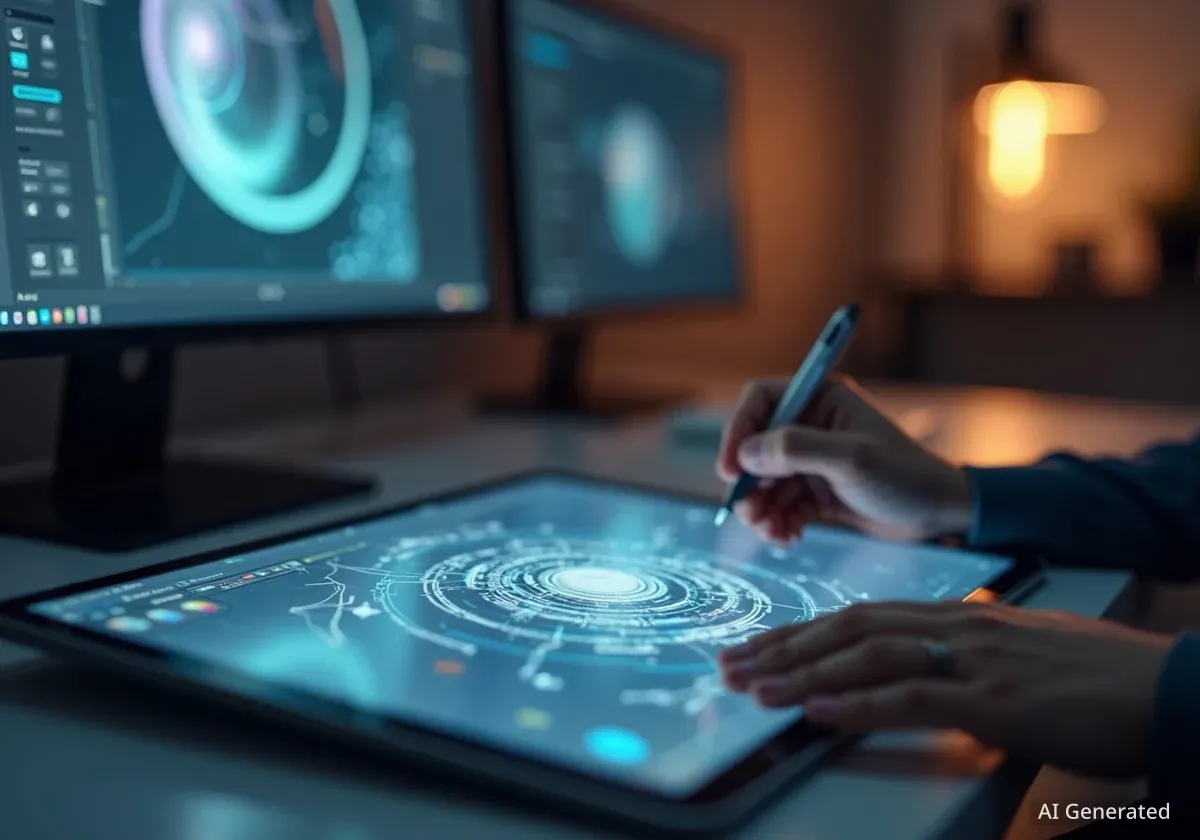A recent experiment explored how artificial intelligence (AI) can assist in graphic design workflows. The trial used Perplexity AI to structure the design process, offering guidance for tools like Krita and Figma. This approach aimed to streamline creative tasks and reduce decision fatigue, though it also revealed limitations in AI's ability to interpret complex visual nuances without direct human input.
Key Takeaways
- AI can structure design workflows and provide foundational principles.
- Perplexity AI was used to offer style exploration and tool-specific advice.
- The AI proved effective for reducing decision fatigue and suggesting next steps.
- Limitations arose when AI could not visually interpret design elements.
- Human oversight remains crucial for aesthetic judgment in creative projects.
Integrating AI into the Design Process
Traditionally, graphic design often involves a mix of tutorials, online forums, and trial-and-error within design software. This can lead to a fragmented and time-consuming process. The recent experiment sought to introduce a structured approach by leveraging AI as a design guide. The goal was not for the AI to create designs directly, but to provide a framework and direction.
Two primary design tools, Krita and Figma, were used in the workflow. However, the methodology is adaptable to other creative applications. The focus was on how AI could serve as an extension of the designer's thought process, offering insights and suggestions at various stages of a project.
AI in Design: Quick Facts
- Efficiency: AI tools can automate repetitive tasks, saving designers time.
- Inspiration: AI can suggest color palettes, font pairings, and style trends.
- Learning: AI can help users learn complex software features.
- Limitations: AI currently lacks true creative intuition and visual judgment.
Configuring Perplexity for Creative Tasks
Effective use of AI in design requires careful setup and specific prompting. The experiment highlighted that simply asking random questions yields less valuable results. Perplexity AI possesses contextual memory, meaning it can personalize responses based on previous interactions and provided information.
To optimize the AI for design, personalization settings were adjusted to clearly define objectives. Separate AI threads were created for each design tool (Krita, Figma) and a general workflow thread. This segmentation allowed the AI to develop a specialized understanding for each context.
Before beginning actual design work, initial, general questions were posed in each thread. This process aimed to "train" the AI, attuning it to the specific types of information and guidance sought by the designer. For example, asking about the basics of drawing in Krita helped the AI understand the tool's fundamental operations.
"The way you set it up and structure your threads actually changes the kind of answers you’ll get," stated the designer. "Perplexity has contextual memory, so it can personalize the answers based on the information you give it and what it’s learned from your previous queries."
Receiving Design Guidance from AI
The AI functioned as a dynamic resource, moving beyond a simple search bar. Ongoing threads allowed for layered prompts, integrating style exploration, reference suggestions, and tool-specific advice. In the general workflow thread, questions focused on overarching design principles.
Examples of prompts included:
- "What are the design differences between a modern editorial layout and a minimalist one?"
- "What visual cues make something feel trustworthy in meditation apps?"
Responses from these prompts provided a broad understanding of design landscapes. For instance, the AI suggested "rounded edges and natural imagery" as elements for trustworthy meditation apps, offering a tangible starting point for subsequent design work.
About Perplexity AI
Perplexity AI is an answer engine that uses large language models to provide direct answers to user queries, often citing its sources. Unlike traditional search engines that return a list of links, Perplexity aims to synthesize information from various sources into a coherent response. It leverages real-time web searches and proprietary search indexes.
Applying AI Guidance in Practice
With an initial direction established, the designer moved to practical application. In Krita, the task was to create a simple fish illustration, aligning with the "natural imagery" suggestion. The AI acted as a "sparring partner," refining the design concept.
A specific prompt for the Krita thread was: "What’s a stylized way to depict fish fins without going hyperrealistic?" This helped in developing a particular visual style for the illustration.
After completing the illustration in Krita, the next step involved transferring it to Figma to create a minimalist mobile user interface (UI). The challenge was integrating the fish illustration without disrupting usability or design aesthetics. The workflow thread was again consulted:
"Suggest ways to integrate a fish illustration into a mobile UI so it complements the layout without overwhelming usability, including placement, size, and color."
Perplexity provided actionable suggestions, which included concepts like "rounded corners" for UI elements. This direct guidance helped the designer quickly iterate on the mobile layout, reducing the time spent on fundamental design decisions.
Decision Fatigue in Design
Decision fatigue is a psychological phenomenon where making many decisions depletes one's mental energy, leading to poorer choices or avoidance of further decisions. In design, AI can mitigate this by providing structured options and guiding designers through initial choices.
Identifying AI's Limitations in Visual Creativity
Despite the benefits, the experiment revealed significant limitations in AI's capacity for visual judgment. While Perplexity could suggest abstract concepts like "calming colors" and "rounded corners," it could not visually interpret the actual design being created.
For example, the fish illustration, despite being stylized, contained numerous lines and edges. This complexity inherently clashed with the AI's recommendation for a "minimalist" and "relaxing" visual. Even after providing a detailed prompt with the image file attached, the AI continued to recommend minimalist techniques that did not resolve the visual conflict.
The background of the mobile layout appeared visually busy due to this mismatch. The AI's inability to 'see' the design meant it defaulted to known patterns rather than adapting to the specific visual context. This highlighted a critical gap: AI can interpret text-based prompts but lacks the human eye's ability to recognize aesthetic suitability in a visual context.
The Need for Human Oversight
Ultimately, the solution to the clashing design elements required human intervention. The designer concluded that a more minimalist fish illustration was needed from the outset. This emphasized that while AI is a powerful tool for guidance and structure, human intuition and aesthetic judgment remain indispensable in creative fields.
The experiment concluded that AI, specifically Perplexity, excels at providing foundational design principles, inspiration, and workflow structure. It effectively pulls and organizes existing information from the web. However, it does not truly understand the nuances of a specific visual design unless an extremely detailed, descriptive prompt is provided that accounts for human perception.
Integrating AI into a design workflow is still recommended for tasks like generating color palette ideas or recalling design tool shortcuts. However, designers must apply their own visual judgment to achieve optimal creative results.




